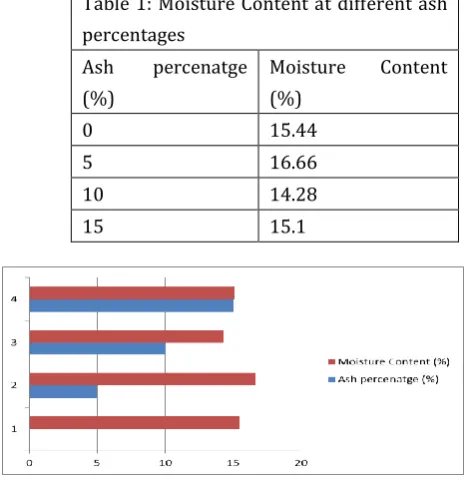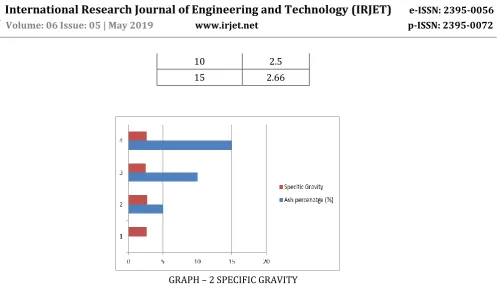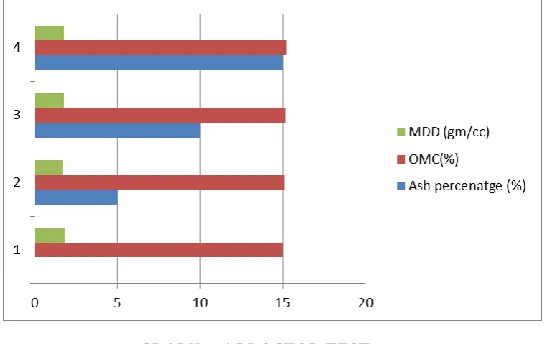© 2019, IRJET | Impact Factor value: 7.211 | ISO 9001:2008 Certified Journal | Page 4668
SOIL STABILISATION WITH MUNICIPAL SOLID WASTE ASH
Shikha Sachan
1, Sanyam Jain
2, Ravinder Bainsla
3, Shubham Dangwal
4,Sam Abbas
5,Shubham
Sharma
61
Assistant Professor, Department of Civil Engineering, Dr. Akhilesh Das Gupta Institute of Technology &
Management, New Delhi, India
2,3.4,5,6.
Student, Department of Civil Engineering, Dr. Akhilesh Das Gupta Institute of Technology &
Management, New
Delhi, India
Abstract: This report presents the analysis of municipal waste ash in soil stabilization for different engineering properties. As solid waste disposal being a major environmental problem, because of unviability of lands for disposal. Improper management of solid wastes causes adverse effects on the ecology which may lead to cause possible outbreak of diseases and epidemics. As solid waste disposal being a major environmental problem, as lands for disposal is not so far available and environmental hazard is also major problem.
KEYWORDS: Soil, MSW Ash, Moisture Content, Shrinkage Limit, Specific Gravity, Liquid Limit, Plastic Limit, UCS, CBR, Proctor Test
1 Introduction
The main requirement of soil stabilization is adequate strength and it depends on character of soil. In case of cohesion less soils the strength could be improved by providing confinement or by adding cohesion with a cementing or binding agent. In case of cohesive soil, the strength could be increased by drying, making soil moisture resistant, altering the clay electrolyte concentration, increasing cohesion with a cementing agent and adding frictional properties. Trash or garbage or rubbish is waste type consisting of everyday items that are discarded by the public. They have used lime and Class C fly ash to reduce the plasticity of highly expansive clays. Soil samples with similar classification were used to show shrinkage variability with the addition of lime and Class C fly ash(Borthakur et.al 2014). "Garbage" can also refer specifically to food waste, as in a garbage disposal; the two are sometimes collected separately consists of everyday items we use and then throw away, such as product packaging, grass clippings, furniture, clothing, bottles, food scraps, newspapers, appliances, paint, and batteries. Soil is also a very important property to keep in mind while working with soils. The geotechnical characteristics of fly ash soil specimens, lime-soil specimens and lime-fly ash-soil specimens mixed with different proportions of randomly oriented fibers were investigated (Kumar et.al 2016). The soils may be well-graded which is desirable as it has less number of voids or uniformly well-graded which though sounds stable but has more voids. Expansive soil is a problematic soil for civil engineers because of its low strength and cyclic swell shrink behavior (Patil et.al 2014). Thus, it is better to mix different types of soils together to improve the soil strength properties. It is very expensive to replace the inferior soil entirely soil and hence, soil stabilization is the thing to look for in these cases. Clayey soils usually have the potential to demonstrate undesirable engineering behavior, such as low bearing capacity, high shrinkage and swell characteristics and high moisture susceptibility (Munilakshmi et.al 2015).
2. Materials and Methodology
2.1 Materials
© 2019, IRJET | Impact Factor value: 7.211 | ISO 9001:2008 Certified Journal | Page 4669 2.2 Methodology
In first Stage to find the strength of soil after stabilization with municipal solid waste bottom ash, experiments were conducted in first stage is characteristics of the soil were determined by moisture content, sieve analysis, specific gravity test, liquid limit test, plastic limit test, shrinkage limit test. In the second stage, UCS, CBR, Proctor test of the stabilized soil were determined by using respective apparatus.
3. Results and Discussion
3.1 Moisture Content
In almost all soil tests natural moisture content of the soil is to be determined. The knowledge of the natural moisture content is essential in all studies of soil mechanics. To sight a few, natural moisture content is used in determining the bearing capacity and settlement. The natural moisture content will give an idea of the state of soil in the field.
Table 1: Moisture Content at different ash percentages
Ash percenatge (%)
Moisture Content (%)
0 15.44
5 16.66
10 14.28
15 15.1
Graph – 1 Moisture Content
3.2 Specific Gravity
[image:2.595.165.399.309.551.2]The knowledge of specific gravity is needed in calculation of soil properties like void ratio, degree of saturation etc. Specific gravity G is defined as the ratio of the weight of an equal volume of distilled water at that temperature both weights taken in air.
Table 2: Specific Gravity at
different ash percentages
Ash percenatge (%)
Specific Gravity
0 2.66
© 2019, IRJET | Impact Factor value: 7.211 | ISO 9001:2008 Certified Journal | Page 4670 GRAPH – 2 SPECIFIC GRAVITY
3.3 Liquid Limit
[image:3.595.64.563.46.338.2]Liquid limit is significant to know the stress history and general properties of the soil met with construction. From the results of liquid limit the compression index may be estimated. The compression index value will help us in settlement analysis. If the natural moisture content of soil is closer to liquid limit, the soil can be considered as soft if the moisture content is lesser than liquids limit, the soil can be considered as soft if the moisture content is lesser than liquid limit. The soil is brittle and stiffer.
Table 3: Liquid Limit at different ash percentages
Ash percenatge
(%)
Liquid Limit (%)
0 21.1
5 19.56
10 20
15 19.7
GRAPH – 3 LIQUID LIMIT
10 2.5
© 2019, IRJET | Impact Factor value: 7.211 | ISO 9001:2008 Certified Journal | Page 4671 3.4 Plastic Limit
Soil is used for making bricks, tiles, soil cement blocks in addition to its use as foundation for structures.
GRAPH – 4 PLASTIC LIMIT 3.5 Shrinkage Limit
As the soil loses moisture, either in its natural environment, or by artificial means in laboratory it changes from liquid state to plastic state to semi-solid state and then to solid state. The volume is also reduced by the decrease in water content. But, at a particular limit the moisture reduction causes no further volume change. A shrinkage limit test gives a quantitative indication of how much moisture can change before any significant volume change and to also indication of change in volume. The shrinkage limit is useful in areas where soils undergo large volume changes when going through wet and dry cycles (e.g. earth dams).
Table 5: Shrinkage Limit at different ash percentages
Ash percenatge
(%)
Shrinkage Limit(%)
0 18.51
5 19.09
10 21.71
[image:4.595.186.416.148.467.2]15 16.51
Table 4: Plastic Limit at different ash
percentages Ash
percenatge (%)
Plastic Limit(%)
0 12.5
5 15
10 14.94
© 2019, IRJET | Impact Factor value: 7.211 | ISO 9001:2008 Certified Journal | Page 4672 GRAPH – 5 SHRINKAGE LIMIT
3.6 Proctor Test
Compaction is the process of densification of soil by reducing air voids. The degree of compaction of a given soil is measured in terms of its dry density. The dry density is maximum at the optimum water content. A curve is drawn between the water content and the dry density to obtain the maximum dry density and the optimum water content.
[image:5.595.170.445.369.541.2]GRAPH – 6 PROCTOR TEST
Table 6: OMC and MDD at different ash percentages Ash
percenatge (%)
OMC(%) MDD (gm/cc)
0 15 1.84
5 15.1 1.67
10 15.15 1.77
© 2019, IRJET | Impact Factor value: 7.211 | ISO 9001:2008 Certified Journal | Page 4673 3.7 UCS Test
The unconfined compressive strength (qu) is the load per unit area at which the cylindrical specimen of a cohesive soil falls in compression.
qu = P/A
[image:6.595.183.406.266.572.2]Where P= axial load at failure, A= corrected area = , where is the initial area of the specimen, = axial strain = change in length/original length. The undrained shear strength (s) of the soil is equal to the one half of the unconfined compressive strength,
Table 7: UCS at different ash percentages
Ash percenatge
(%)
Compressive Stress(KN/m2)
0 24.3
5 25.5
10 25.8
15 26
GRAPH – 7 UCS TEST
3.8 CBR Test
The california bearing ratio test is penetration test meant for the evaluation of subgrade strength of roads and pavements. The results obtained by these tests are used with the empirical curves to determine the thickness of pavement and its component layers. This is the most widely used method for the design of flexible pavement.
© 2019, IRJET | Impact Factor value: 7.211 | ISO 9001:2008 Certified Journal | Page 4674 Table 8: CBR at different
ash percentage Ash
percenatge (%)
AT 2.5mm
AT 5mm
0 5.03 5.9
5 5.3 8.2
10 6.04 8.5
15 6.4 8.5
GRAPH -8 CBR TEST
4. Conclusions
In this Study, the stabilization of a soil with municipal solid waste ash was investigated and the effects of the stabilization on the soil properties of a soil were studied. Experimental study of soil stabilization with municipal solid waste ash shows use of municipal solid waste in 10% with soil enhances soil properties like stength, compaction. This study shows instead of having simply disposal of msw, which is not possible due to lack of land availability, we can improve soil properties by using waste ash.Using waste ash as a stabilizing material is cheap as well as eco-friendly method of soil stabilization, which solves the waste disposal problems as well as enhances soil properties. For different areas soil and different waste , we can have different optimum percentage of waste ash which will enhance soil properties.
5. References
Kumar and Munilakshmi (2015) “Analysis of Strength Characteristics of Black Cotton Soil Using Bagasse Ash and Additives as Stabilizer” International Journal of Engineering Research & Technology.
Kumar, et al. (2016), “Influence of fly ash, lime, and polyest er fibers on compaction and strength properties of expansive Soil”, Journal of Materials in Civil Engineering.
Kumar A. and Patil S. (2014), “A Review of Literature on Stabilization of Expansive Soil Using Solid Wastes” International Journal of Engineering Research & Technology.
Borthakur N. and Singh M. S. (2014) “Stabilization of Peat soil using locally available admixture”.
© 2019, IRJET | Impact Factor value: 7.211 | ISO 9001:2008 Certified Journal | Page 4675
Kharade A. S., Suryavanshi V. V. and Deshmukh R. R. (2014) “Waste Product Bagasse Ash' From Sugar Industry Can Be Used As Stabilizing Material For Expansive Soils” IJRET: International Journal of Research in Engineering and Technology.
Kerni V., Kumar V. and Jan U. (2013), “Review on Stabilization of Clayey Soil Using fines Obtained from Demolished Concrete.
Sezer, A., Inan, G., Yılmaz, H.R., & Ramyar, K. (2010), “Utilization of a very high lime fly ash for improvement of clay”.
IS CODE 2720-PART2-1973: Oven Dry Test
IS CODE 2720-PART-3-1980: Specific Gravity Test
IS CODE 2720-PART-5-1985: Liquid Limit Test & Plastic Limit Test
IS CODE 2720-PART-6-1972: Shrinkage Limit Test
IS CODE 2720-PART-7-1980: Proctor Test
IS CODE 2720-PART-16-1987: CBR Test
IS CODE 2720-PART-4-1985: Grain Size Test





